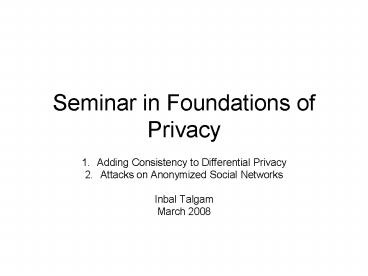Seminar in Foundations of Privacy - PowerPoint PPT Presentation
Title:
Seminar in Foundations of Privacy
Description:
Seminar in Foundations of Privacy. Adding Consistency to Differential Privacy ... privacy for a query of sensitivity ?f, add Laplace noise with s = ?f/e. ... – PowerPoint PPT presentation
Number of Views:41
Avg rating:3.0/5.0
Title: Seminar in Foundations of Privacy
1
Seminar in Foundations of Privacy
- Adding Consistency to Differential Privacy
- Attacks on Anonymized Social Networks
- Inbal Talgam
- March 2008
2
1. Adding Consistency to Differential Privacy
3
Differential Privacy
- 1977 Dalenius - The risk to ones privacy is the
same with or without access to the DB. - 2006 Dwork Naor Impossibe (auxiliary info).
- 2006 Dwork et al The risk is the same with or
without participating in the DB. - Plus Strong mechanism of Calibrated Noise to
achieve DP while maintaining accuracy. - 2007 Barak et al - Adding consistency.
4
Setting Contingency Table and Marginals
0 1 0 0 1 1 1 0 0 0 1 0 1 0
n participants
DB
k binary attributes
Terminology Contingency table (private),
marginals (public).
5
Main Contribution
- Solve following consistency problem
- At low accuracy cost
6
Outline
- Discussion of
- Privacy
- Accuracy Consistency
- Key method - Fourier basis
- The algorithm
- Part I
- Part II
7
Privacy Definition
- Intuition The risk is the same with or without
participating in the DB - Definition
A randomized function K gives e-differential
privacy if for all DB1, DB2 differing on at most
1 element
DB1
DB2
Differing on 1 element
8
Privacy - Mechanism
K(DB) f(DB)
9
The Calibrated Noise Mechanismfor DP
- Main idea Amount of noise to add to f(DB) is
calibrated according to the sensitivity of f,
denoted ?f. - Definition
- All useful functions should be insensitive
- (e.g. marginals)
10
The Calibrated Noise Mechanism How Much Noise
- Main result To ensure e-differential privacy for
a query of sensitivity ?f, add Laplace noise with
s ?f/e. - Why does it work? Remember
- Laplace Definition
- PrK(DB)a
- exp (f(DB) - a1 / s)
11
Accuracy Consistency
So smoking is one of the leading causes of
statistics?
- Compromise consistency
- May lead to technical problems and confusion
12
Key Approach
Small number of coefficients of the Fourier basis
- Non-redundant representation
- Specific for required marginals
Consistency Any set of Fourier coefficients
correspond to a (fractional and possibly
negative) contingency table.
Accuracy Few Fourier coefficients are needed for
low-order marginals, so low sensitivity and small
error.
Linear Programming Rounding
13
Accuracy What is Guaranteed
- Let C be a set of original marginals, each on j
attributes. - Let C be the result marginals.
- With probability 1-d,
- Remark Advantage of working in the interactive
model.
14
Outline
- Discussion of
- Privacy
- Accuracy Consistency
- Key method - Fourier basis
- The algorithm
- Part I
- Part II
15
Notation Preliminaries
x00
x01
- x1 ?
- We say a ß if ß has all as attributes (and
more) - e.g. 0110 0111 but not 0110 0101
- Introduce the linear marginal operator Cß
- ß determines attributes
- Remember xa, a ß, Cß(x), Cß(x)?
16
The Fourier Basis
- Orthonormal basis for space of contingency tables
x (R2k). - Motivation Any marginal Cß(x) can be written as
a combination of few fas. - How few? Depends on order of marginal.
- fa
17
Writing marginals in Fourier Basis
- Theorem
18
Outline
- Discussion of
- Privacy
- Accuracy Consistency
- Key method - Fourier basis
- The algorithm
- Part I adding calibrated noise
- Part II non-negativity by linear programming
19
Algorithm Part I
- INPUT Required marginals Cß
- fa Fourier vectors needed to write marginals
- Releasing marginals Cß(x) releasing coeffs
ltfa,xgt - OUTPUT Noisy coeffs Fa
- METHOD Add calibrated noise
- Sensitivity depends on a on order of
Cßs
20
Part II Non-negativity by LP
- INPUT Noisy coeffs Fa
- OUTPUT Non-negative contingency table x'
- METHOD Minimize difference between Fourier
coefficients - Most entries x'? in a vertex solution are 0
- Rounding adds small error
21
Algorithm Summary
- Input Contingency table x, required marginals
Cß - Output Marginals Cß of new contingency table
x'' - fa Fourier vectors needed to write marginals
- Compute noisy Fourier coefficients Fa
- Find non-negative x' with nearly the correct
Fourier coefficients - Round to x''
22
Accuracy Guarantee - Revisited
- With probability 1-d,
Coefficients
23
Summary Open Questions
- Algorithm for marginals release
- Guarantees privacy, accuracy consistency
- Consistency can reconstruct a synthetic,
consistent table - Accuracy error increases smoothly with order of
marginals - Open questions
- Improving efficiency
- Effect of noise on marginals statistical
properties
24
Any Questions?































